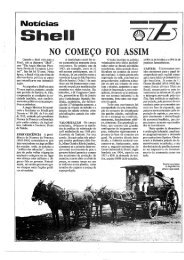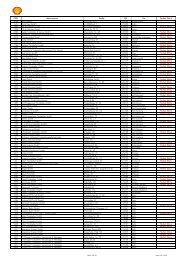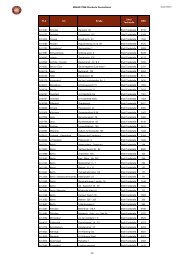Safety Data Sheet
Safety Data Sheet
Safety Data Sheet
Create successful ePaper yourself
Turn your PDF publications into a flip-book with our unique Google optimized e-Paper software.
<strong>Safety</strong> <strong>Data</strong> <strong>Sheet</strong><br />
Specific hazards arising<br />
from Chemicals<br />
Suitable Extinguishing<br />
Media<br />
Unsuitable Extinguishing<br />
Media<br />
Protective Equipment &<br />
Precautions for Fire<br />
Fighters<br />
Low Boiling Point Naphtha<br />
Version 2.2<br />
Effective Date 14.06.2012<br />
IMO (International Maritime Organization) MSDS<br />
per SOLAS regulation VI/5-1<br />
: Hazardous combustion products may include: A complex<br />
mixture of airborne solid and liquid particulates and gases<br />
(smoke). Carbon monoxide. Unidentified organic and inorganic<br />
compounds. The vapour is heavier than air, spreads along the<br />
ground and distant ignition is possible. Will float and can be<br />
reignited on surface water.<br />
: Foam, water spray or fog. Dry chemical powder, carbon<br />
dioxide, sand or earth may be used for small fires only.<br />
: Do not use water in a jet.<br />
: Proper protective equipment including breathing apparatus<br />
must be worn when approaching a fire in a confined space.<br />
Additional Advice : If the fire cannot be extinguished the only course of action is to<br />
evacuate immediately. Keep adjacent containers cool by<br />
spraying with water. If possible remove containers from the<br />
danger zone. Contain residual material at affected sites to<br />
prevent material from entering drains (sewers), ditches, and<br />
waterways.<br />
6. ACCIDENTAL RELEASE MEASURES<br />
Observe the relevant local and international regulations. Avoid contact with skin, eyes and<br />
clothing. Evacuate the area of all non-essential personnel. Ventilate contaminated area<br />
thoroughly. Avoid contact with spilled or released material. Immediately remove all contaminated<br />
clothing. For guidance on selection of personal protective equipment see Chapter 8 of this<br />
Material <strong>Safety</strong> <strong>Data</strong> <strong>Sheet</strong>. For guidance on disposal of spilled material see Chapter 13 of this<br />
Material <strong>Safety</strong> <strong>Data</strong> <strong>Sheet</strong>. If contamination of sites occurs remediation may require specialist<br />
advice. Ensure electrical continuity by bonding and grounding (earthing) all equipment. Take<br />
precautionary measures against static discharges.<br />
Personal Precautions,<br />
Protective Equipment and<br />
Emergency Procedures<br />
Environmental<br />
Precautions<br />
Methods and Material for<br />
Containment and Clean<br />
: Vapour can travel for considerable distances both above and<br />
below the ground surface. Underground services (drains,<br />
pipelines, cable ducts) can provide preferential flow paths. Do<br />
not breathe fumes, vapour. Take measures to minimise the<br />
effects on groundwater. Contain residual material at affected<br />
sites to prevent material from entering drains (sewers), ditches,<br />
and waterways.<br />
: Shut off leaks, if possible without personal risks. Remove all<br />
possible sources of ignition in the surrounding area. Use<br />
appropriate containment (of product and fire fighting water) to<br />
avoid environmental contamination. Prevent from spreading or<br />
entering drains, ditches or rivers by using sand, earth, or other<br />
appropriate barriers. Attempt to disperse the vapour or to direct<br />
its flow to a safe location for example by using fog sprays.<br />
Take precautionary measures against static discharge. Ensure<br />
electrical continuity by bonding and grounding (earthing) all<br />
equipment.<br />
: For large liquid spills (> 1 drum), transfer by mechanical means<br />
such as vacuum truck to a salvage tank for recovery or safe<br />
4/14<br />
Print Date 15.06.2012 000000021522<br />
MSDS_IMO






![Download Shell AutoGas Stationen [Stand: August 2011]](https://img.yumpu.com/7453880/1/184x260/download-shell-autogas-stationen-stand-august-2011.jpg?quality=85)